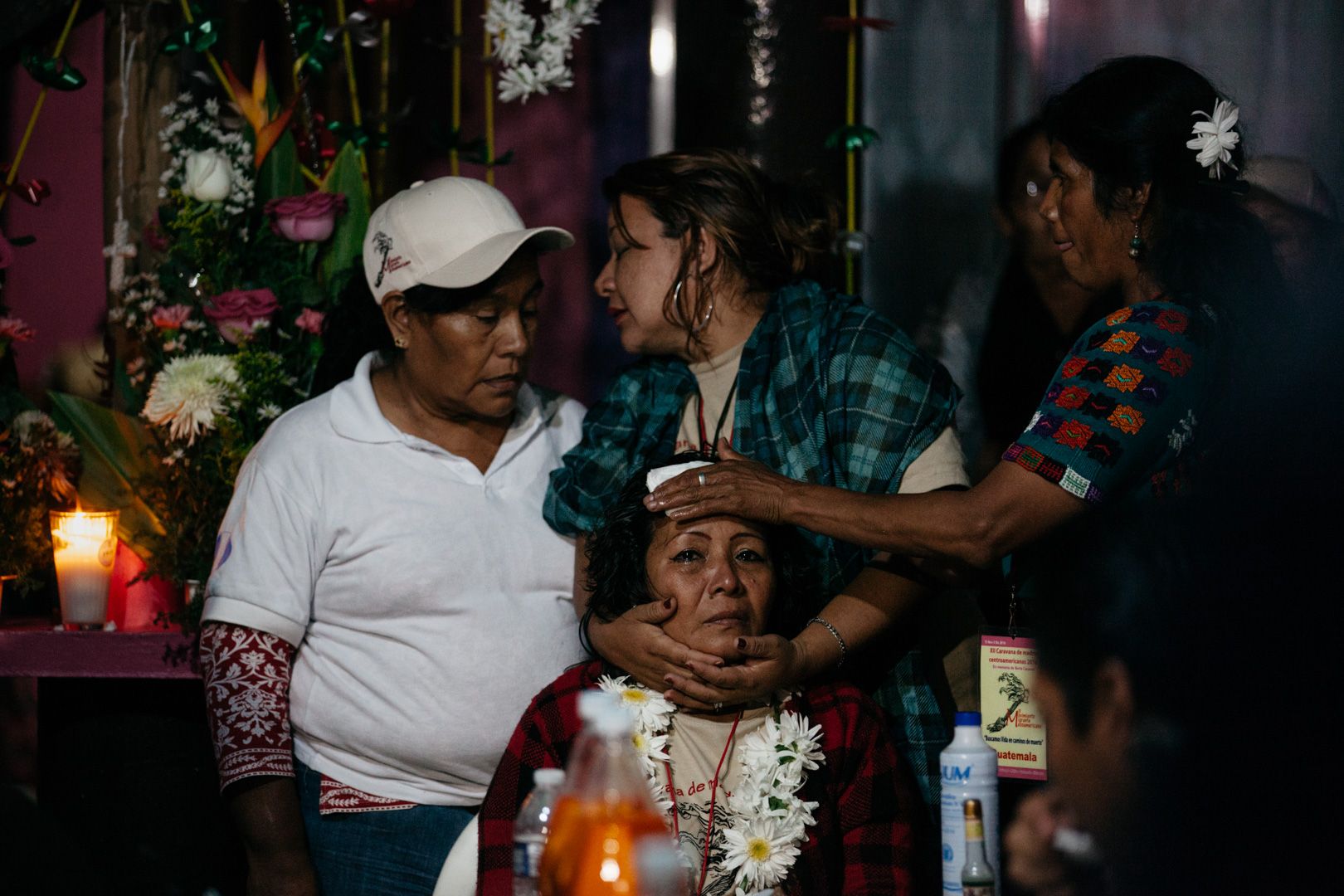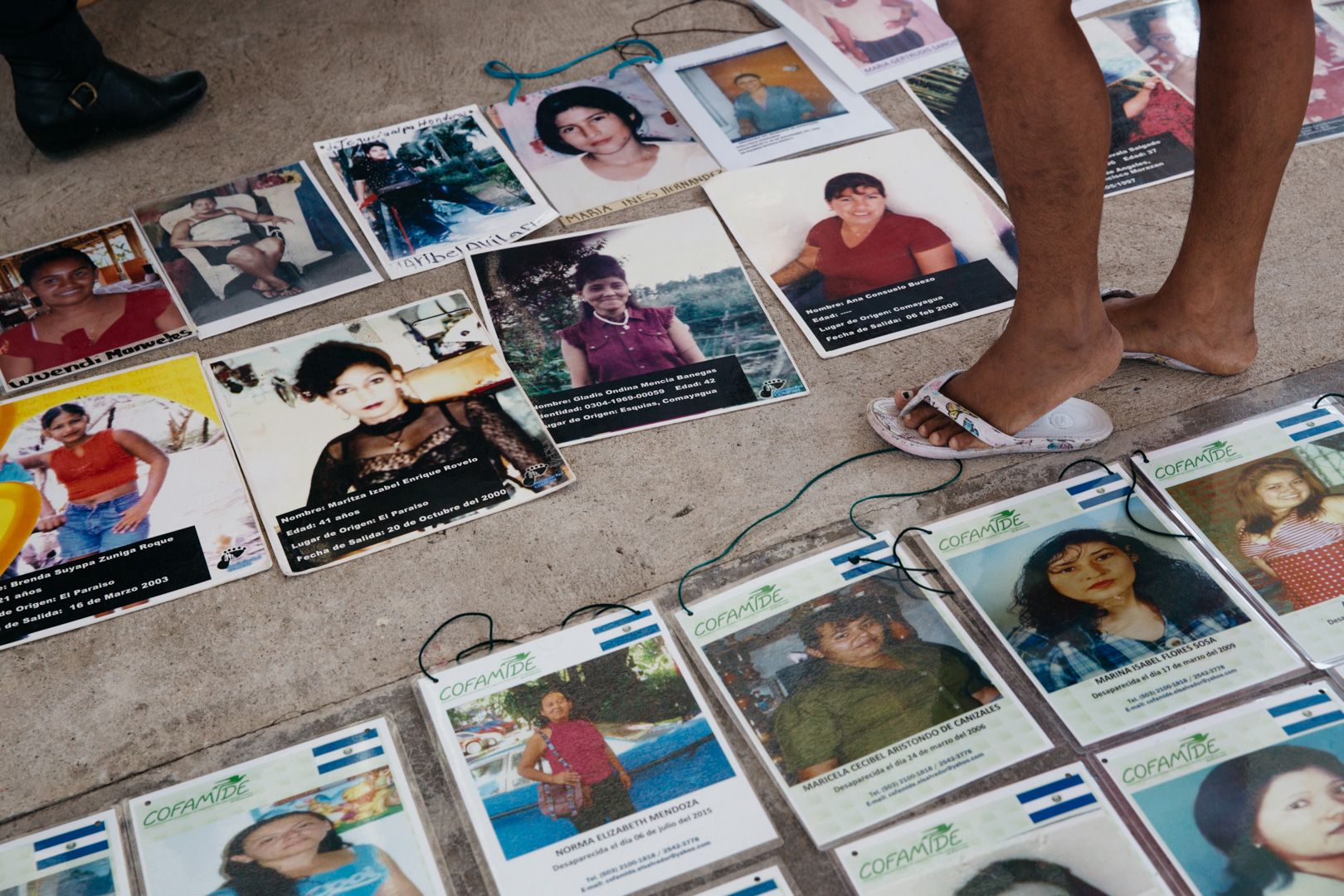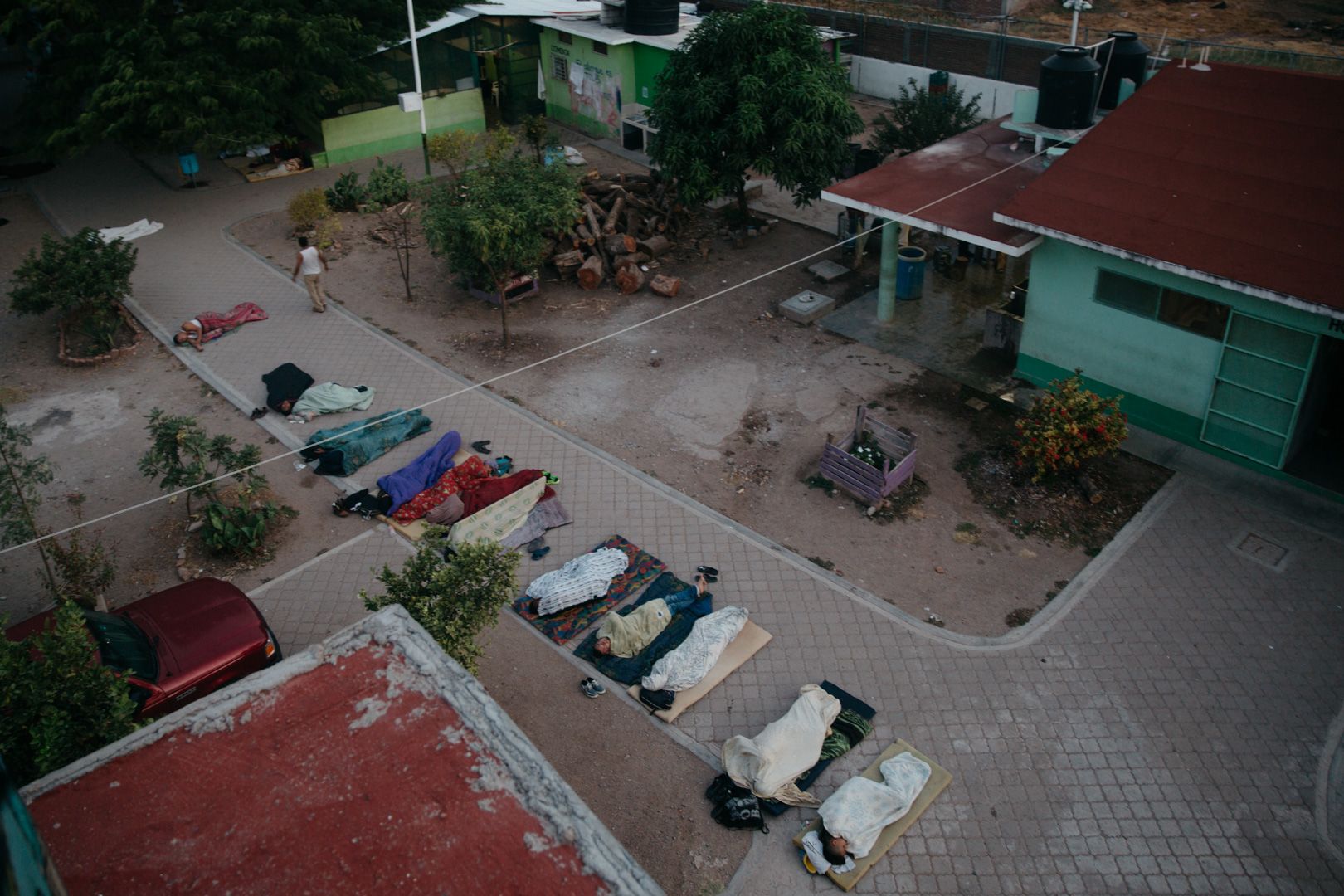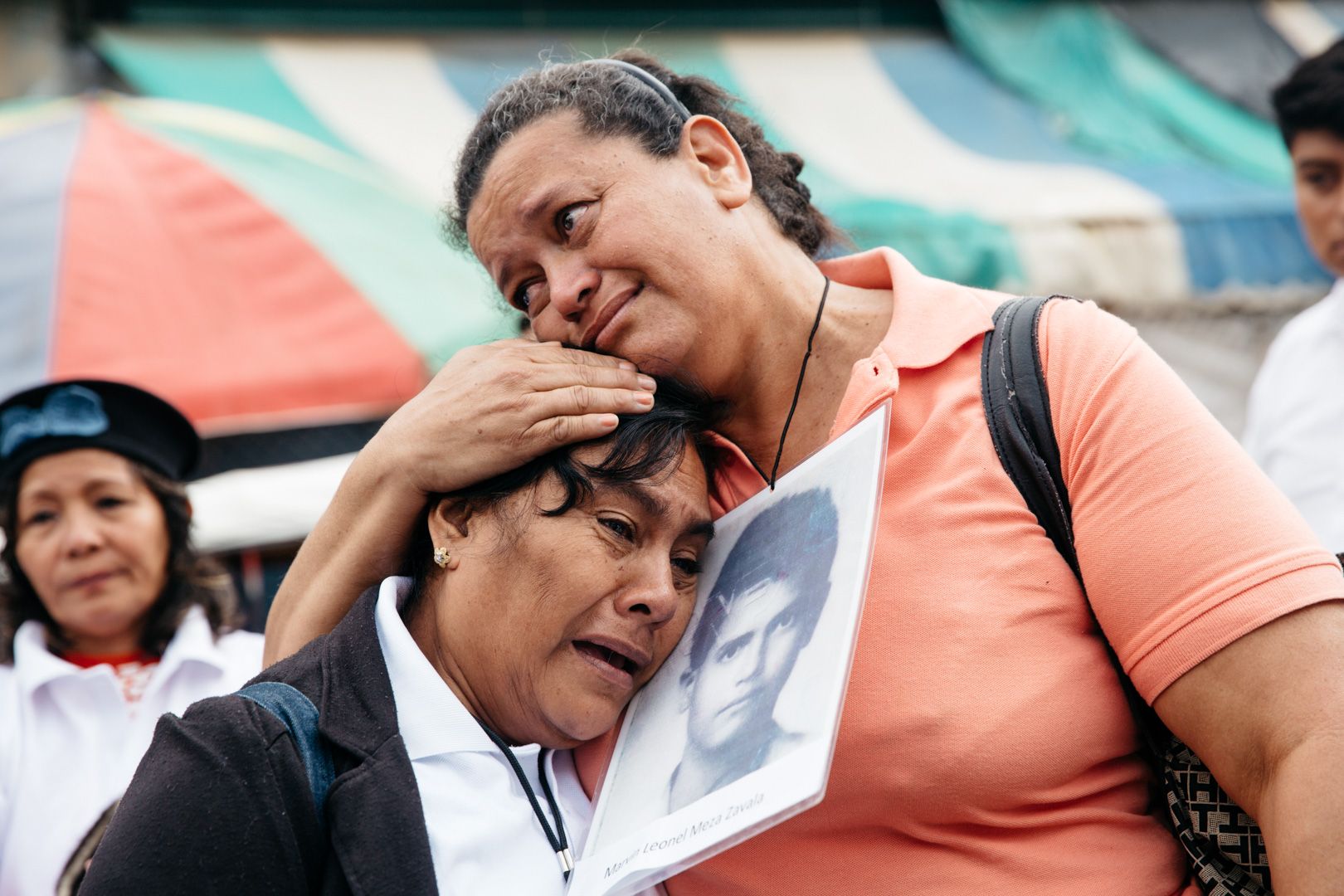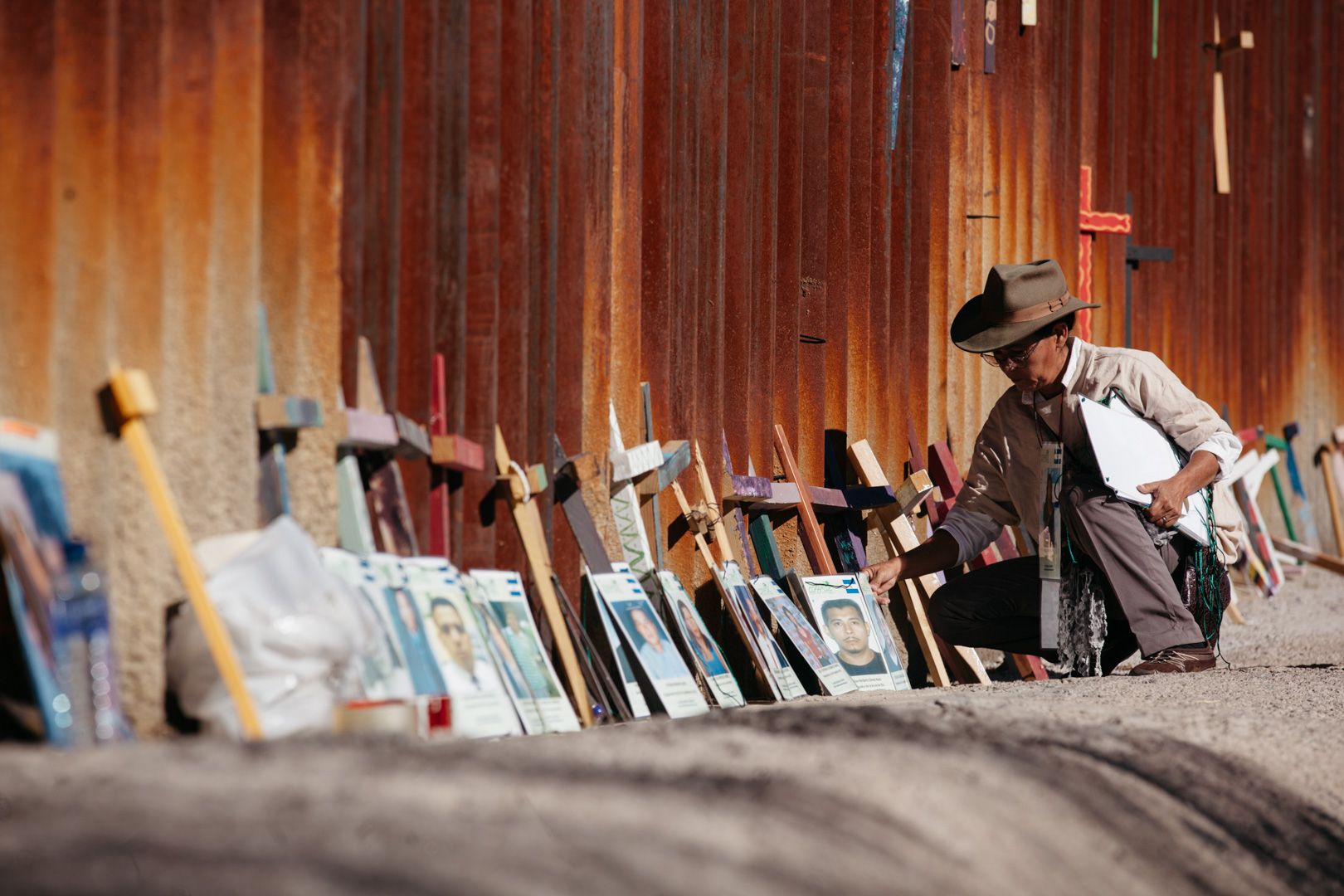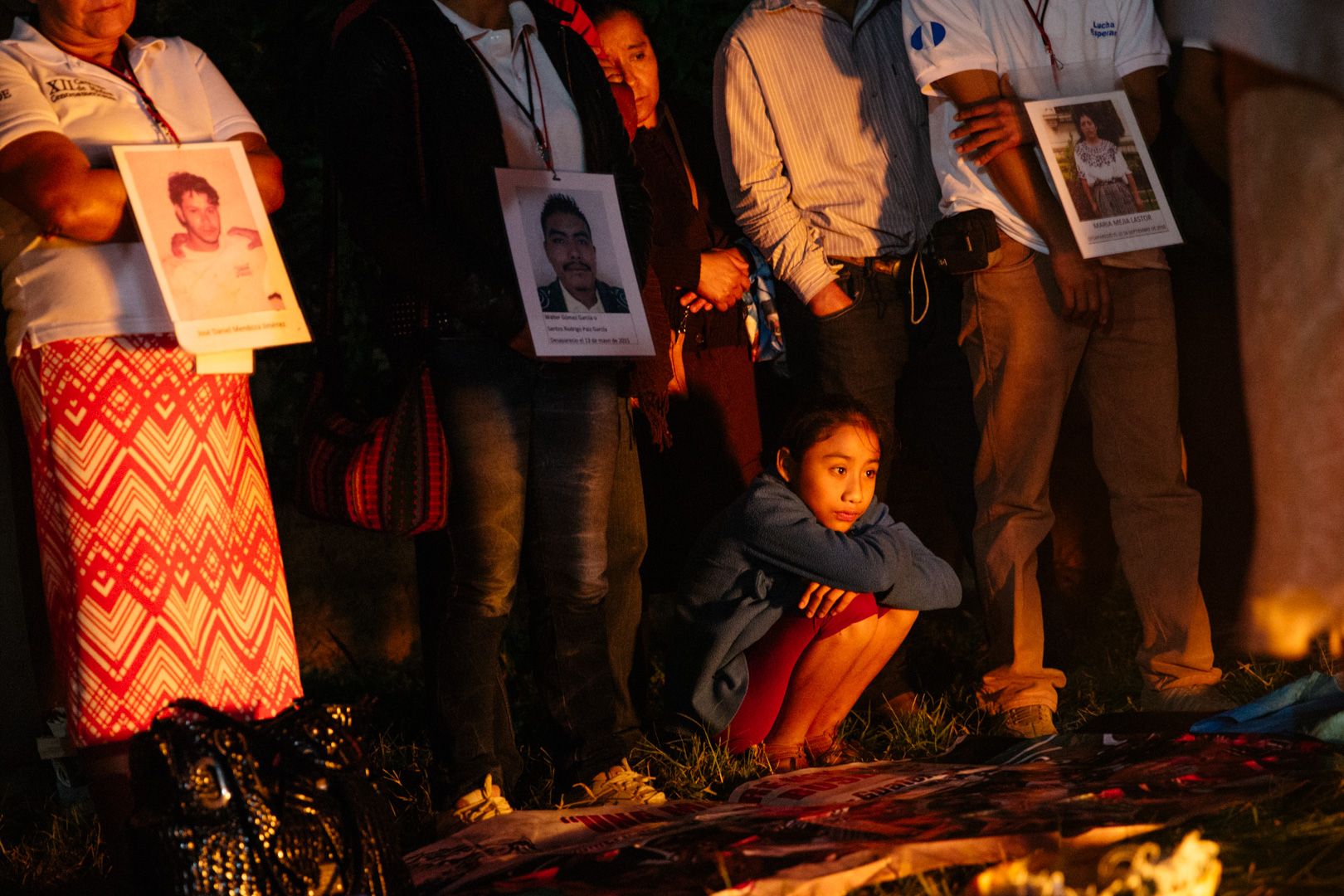HUIXTLA, Mexico — María Mercedes Lemus raised her daughter the old-fashioned way, rooted in family and faith. Yet late one December night, the 60-year-old Honduran found herself standing in the greasy yellow light of a brothel entrance in southern Mexico, praying that her daughter was inside.
Ana Victoria Lemus had set out for the United States in March 2010 at the age of 17, chasing the promise of a life better than the one she had in Honduras. She phoned her mother from the northern Mexican border city of Reynosa, saying she was to be smuggled into Texas the next day.
Then she vanished.
While many Central American parents are left to wonder what has become of their disappeared loved ones, Lemus could not let it go. She uncovered a few leads, but nothing came of them. In desperation, she joined the XII Caravana de Madres Centroamericanas, a group of mostly mothers who make an annual trek through Mexico on a seemingly impossible mission, looking for the missing.
It was another woman in the caravan, following a lead for her own relative, who had unexpectedly run across signs of Lemus’ daughter.
On a sweltering night earlier this month, more than 1,000 miles from where she had last heard from her daughter, Lemus stood in a red light district, wearing a laminated photo of Ana Victoria around her neck. Drunken men pointed at the image, offering lewd comments rather than leads. A couple of prostitutes said they recognized the girl, though they knew her by a different name, and said she was working in a guarded brothel.
Just outside, a man with two young women at his side strolled past Lemus, a bodyguard missing an eye following closely behind them. Lemus steeled herself, and asked to be let in.
"If you go in, you aren’t coming out," the doorman warned her and three others accompanying Lemus that night.
"We all felt the danger," Lemus said, explaining why she and her small group had little choice but to turn back. Yet the disappointment was tempered by renewed hope, however tenuous.
The caravan’s heart-wrenching journey is such that the mere prospect of finding a daughter as a possible victim of sex trafficking is seen as one of the few highlights after three weeks on the road, searching across more than 3,000 miles of Mexico.
By most estimates, at least 70,000 Central American migrants have been forcibly disappeared in Mexico over the past decade. Others say the number of disappeared is above 100,000, but no one knows for certain. While the journey through Mexico has never been easy, for tens of thousands of Central Americans it is arguably more dangerous than ever.
Migrants’ undocumented status, and the routes they navigate through hotly contested drug-trafficking corridors, make them an easy, and profitable, target for kidnapping and extortion. The situation has deteriorated since the start of Mexico’s Southern Border Plan in late 2014. Pressured by the United States to stem the tide of migrants fleeing the violence-plagued Northern Triangle of El Salvador, Honduras and Guatemala, immigration officials pinched off well-trodden routes, pushing vulnerable people further into the shadows.
Mexico now apprehends more Central Americans than the United States — 190,000 in Mexico compared to 117,000 in the U.S. from October 2015 to September 2016 — which critics say has largely exported the refugee crisis to its neighbor. In spite of the crackdown, the exodus of desperate people casting their lot with smugglers continues unabated. Many migrant communities fear conditions will worsen under President-elect Donald Trump.
In this increasingly hostile environment, the mothers’ caravan, which this year included a few fathers, sisters and brothers, scoured prisons and brothels and applied pressure to law enforcement and politicians in an effort to call attention to their missing family members.
David Alexander Jarquin Pineda disappeared in Reynosa. Jarvin Josue Velasquez Lacayo was last seen in Piedras Negras. Hector Rodriguez vanished in Nuevo Laredo. And in July 2013, Gilver Josue Alvares walked into the yawning desert between Sonora and Arizona.
None have been heard from since.
Gilver was a skinny 14-year-old with migrant dreams. He promised his mother he wouldn't do anything rash, like follow his cousins out of Honduras, but he longed for the triumphant spoils that are the domain of emigrants. He imagined himself in a shiny pickup truck, and providing a home for his hard-working mother. Impulse got the better of him as his cousins walked out the door while his mother was at work, and Gilver raced to join them.
“He left without saying goodbye,” his mother, Nohemy Yamileth Alvares, recalled sullenly. “He was so small.”
Last contact in the desert
Alvares was raising Gilver and his older brother, Darwin, on her own, struggling to make the $50 she earned cooking for well-to-do families in the capital of Tegucigalpa stretch to the end of the month.
When Gilver called to say he was with his cousins, Gustavo and Pedro Luis, they assured their aunt they would look out for him. She kept tabs on them via Facebook. Their last conversation came from Caborca, Sonora, a notorious staging point where immigrants make arrangements with smugglers to traverse the unforgiving desertscape into Arizona.
Later, Gustavo would tell his aunt that they had been walking in the desert for four days. He said he and Pedro Luis left Gilver with the smuggler to search for water. When they heard trucks approaching, they instinctively ducked for cover. By the time they returned, Gilver and the smuggler were gone.
Alvares, 41, has downcast dark eyes, and wears her hair pulled back tightly in a bun. In late November, she and another caravan member, Liliam Hortensia Morales Jovel, a soft-spoken 50-year-old Salvadoran searching for her younger sister, Jacqueline, broke off from the group to search for clues on the Mexican-Arizona border.
Neither had come so close to the ground where Gilver and Jacqueline had vanished. Alvares had not expected to make the trip at all. After the Honduran organization extended an invitation to join the caravan, she decided that God must have something in store for her.
Alvares was often contemplative during the journey, consumed by sorrow and regret. She once had been an opportunity to immigrate to the Los Angeles when her boys were young, but she couldn’t leave them at such a tender age. If she had gone, she likely would have been able to provide her boys the things they needed and, she wondered, perhaps Gilver wouldn’t have felt compelled to leave home.
Six months after Gilver disappeared someone claiming to have him captive. The person demanded $1,000 ransom, but it was just someone trying to profit from her anguish.
“I was at the point of falling into depression,” Alvares said. “Sometimes I just think of him and I cry.”
A disturbing phenomenon
Desperate Central American mothers began venturing into Mexico years ago to look for their missing sons and daughters. Eventually families of the disappeared organized in El Salvador, Honduras, Guatemala and Nicaragua. For the past dozen years, these groups have formed the Mesoamerica Migrant Movement; the mothers’ caravan is part of the movement. This year’s edition adopted the maxim “searching for life on roads of death.”
In the early days, the grassroots social movement toiled in relative obscurity. Then in 2010, a bedraggled Ecuadoran immigrant stumbled into a military checkpoint in the northern Mexican border state of Tamaulipas. Over parched lips the man spoke of horrors on a remote ranch near the town of San Fernando. There marines found the decomposing remains of 72 Central and South American immigrants who were executed for refusing to join the Zetas, a savage drug cartel operating with near total impunity in the region.
Through this chance encounter, a nation awoke to a disturbing phenomenon. The following year 193 more migrants were unearthed in dozens of mass graves across Tamaulipas, and still more were discovered in Nuevo León in 2012.
In a nation facing its own epidemic of disappearances, Mexico’s National Registry of Disappeared and Missing Persons has on record just a couple of hundred cases of disappeared migrants. Meanwhile, the National Human Rights Commission reports the incidence of migrant kidnappings has soared into the tens of thousands.
“The majority of disappeared cases over the last 10 years were completely forced,” said Ruben Figueroa, an activist with the movement and investigator of disappeared migrants. “Many of them are probably dead.”
This stark reality hasn’t kept Figueroa from searching. Ahead of each caravan, organizers pore over official documents, photos and letters, and they meticulously interview family members, anything that might give rise to a lead. Over the past several years Figueroa, a former migrant, has been at this chaotic epicenter.
As a teenager, Figueroa became keenly aware of the poverty that permeated his neighborhood. Opportunities were for the wealthy families for whom his mother washed and ironed.
It was the late 1990s and Mexicans were migrating north in droves. At the age of 16, Figueroa packed his birth certificate and joined them. He made it across the border into Texas on his third attempt, eventually settling in North Carolina.
Over the next six years he worked factory and construction jobs. The experience awakened in Figueroa a profound sense of injustice, pulling him inexorably back to his roots and the migrant trail. One day while back in Mexico, Figueroa’s eyes welled with tears as he gazed upon dozens of migrants riding atop a northbound train. He made up his mind then to do something.
His family began by inviting migrants to a hot meal, and to sleep in their home, aware they were inviting unwanted attention from criminal networks and police. Trouble eventually found him. By the mid-2000s the Zetas had descended upon the land, ushering in a period of mass kidnappings and disappearances. Figueroa and a fearless group of activists and religious leaders documented the abuses.
Figueroa is now 34 and thickset with a swirl of dark hair. He made a name for himself tracking smugglers by their distinctive tattoos and scars, or colorful nicknames. They learned how smugglers reeled in unsuspecting migrants, and they believed they were making a difference. But everything comes at a price.
Word had come down the Zetas were looking to kill Figueroa and his mother. Figueroa skipped town for a few days until things calmed down. In his view, in spite of the sacrifices he and his group have made, migrants are more exposed than ever.
“There is a policy of repression, of militarization, that’s why people die, not just because the border is dangerous,” Figueroa said. “The authorities can say that traffickers do these things, but the policies of migration force immigrants into their hands.”
This is particularly true along the U.S.-Mexico border. Migrants earn hard-won passage by carrying drug-laden backpacks through the desert. In Tamaulipas, the state with the highest rate of missing persons, when a migrant disappears, it’s unlikely that anyone will search for them there. Thousands more have succumbed in punishing heat of the Arizona desert and South Texas scrubland.
Raising awareness
Another member of this year’s caravan was Walter Omar Jarquin Roque, 49, a square-jawed father of three from El Salvador. He also took a side trip from the caravan’s main route, looking for his son, David Jarquin Pineda, amid the menacing industrial sprawl of Reynosa.
In 2014, Jarquin’s son had scraped together a few hundred dollars, and his father had pitched in the rest, selling his house, Jeep Cherokee and a revolver to help the 23-year-old chase his version of the American dream. Jarquin gave his son his best advice and put him in God’s hands.
David called the evening before he was to cross the Rio Grande. It was a moment they had prepared for.
“He said everything was OK,” Jarquin recalled.
Two and half years have come and gone without word from David. After he disappeared, Jarquin received extortion attempts, but the former police officer sniffed out the scams. Dark thoughts colonize his mind. Is his son being tortured? Is he in prison, or worse? He sought therapy in Soyapango, a satellite city on the outskirts of San Salvador. Some suggested he move on.
“The pain is something you learn to survive,” Jarquin said. “If we never find each other that pain will always be there.”
Jarquin was one of the few men to sign up for the caravan, and he quickly gained a reputation for being outspoken about migrant rights. Privately he confessed that each time he opened his heart, he believed it narrowed the distance between him and his son.
Nearing the end of November, Jarquin and two other parents, led by Figueroa, filed complaints with the attorney general’s office in Reynosa. It was a first in a city long thought to be under the corrupting influence of organized crime.
“What they do with the information is another matter,” said Figueroa. “Perhaps they don’t know the reality, or maybe they’re indifferent. We have to wake them up, and above all pressure them to follow through on their promises of an official search.”
For most of its history the caravan ran in relative obscurity. That began to change in the aftermath of the mass kidnapping of 43 students from the Ayotzinapa Rural Teachers' College in Iguala, Guerrero in September 2014. Suddenly the disappeared were thrust into the national conversation. Still in a nation yet grappling with its own disappeared, the plight of migrants is too often ignored.
The caravan movement is largely about bringing visibility to their disappeared. In towns frequented by migrants, the families marched through city streets, chanting slogans: “Listen, son, your mother is in the fight,” and “They were taken alive, and we want them alive,” usually in the presence of the very immigration officials and state police so frequently suspected of mistreating migrants.
In the state of Tabasco, the families faced down state officials, who eagerly pledged to look out for migrant rights, while in the neighboring state of Chiapas, immigration authorities agreed to provide information on migrants who may be held in local prisons. Mexico’s Attorney General’s Office established in December 2015 two units to investigate crimes against migrants and cases of the disappeared, known simply as the Unit and the Mechanism.
Leonor de Jesús Figueroa Jácome heads up the Unit. She touted successfully breaking up rings of kidnappers, but acknowledged that significant challenges remain. Her office has registered barely 120 complaints.
“Many legal departments operate in isolation, and they don’t share information, or they don’t upload it to the attorney general’s office,” Figueroa Jácome said.
Complaints of abuse
Advocates say greater visibility means little in the face of austere immigration enforcement. It wasn’t long after the Southern Border Plan took effect that immigration officials began sweeping up migrants by the thousands.
The U.S. State Department funneled $70 million of its Mérida Initiative assistance in 2014 and 2015 for inspection equipment and canine teams, with tens of millions in additional funding in the pipeline for continued operations on Mexico’s southern border.
In October 2014, a new shelter opened in Chahuites, Oaxaca: the Centro de Ayuda Humanitaria a Migrantes. Between 2014 and 2015, the shelter workers filed 900 cases of abuse with state authorities. In 2016, the number of formal complaints has grown to more than 1,000, and there are no indications that this will slow down soon.
Despite the staggering number of complaints, Jéssica Cárdenas Canuto, the coordinator of the Chauites shelter, says it should come as no surprise that little has come of their efforts. Among the more frequent complaints by migrants is that of bribes paid to Mexican officials. In early October, around two dozen police officers in a neighboring community were arrested in October for kidnapping migrants.
“Despite the high number of complaints since the Southern Border Plan started, not one person has been detained,” Cárdenas said. “It’s very suspicious that in all of this time, two years, the public prosecutor’s office hasn’t found anyone.”
At Hermanos en el Camino, a church-run migrant shelter by the train tracks in Ixtapec, dozens of rough-looking men while away the hours. Some scrub threadbare clothing, others crack jokes while they wait in line for a haircut.
Since the immigration crackdown nearly all of them are biding their time. Once this place was a stopover, a brief respite on the arduous trek north. Migrants would stop for a day or two to rest, and then be on their way. Now 80 percent of them wait for either a humanitarian visa or refugee status.
A majority were assaulted, qualifying them for a humanitarian visa, but many are also fleeing gang violence at home, and therefore qualify for refugee status in Mexico. Both take months to process, which can be a problem for people with limited resource and few job prospects. Most opt for the humanitarian visa because it arrives within two months, and they can be on their way.
‘Bridges of Hope’
Not everyone is forcibly disappeared. Some choose to disappear out of shame or circumstance, but some long to reconnect.
Seven years had passed since Juana del Carmen Amaya’s husband forced her to sever communication with her mother in El Salvador. But when the caravan was in Chahuites, Oaxaca, last year, where Amaya, 29, was now living, she was able to get a local priest to reach out to the caravan leaders for her while her husband was away.
Figueroa tracked down Amaya’s mother, and a reunion was arranged for this year. Near the end of the caravan, the mother and daughter met in a tearful embrace. Reyna Amaya, 45, met the two grandsons who she had never known, and her contrite son-in-law.
The movement calls these reunions "Bridges of Hope" and there have been 269 over the years. They are meant to give the others hope. Realistically, however, most of the families on the caravan face the grim reality that they will never know what has become of their disappeared.
While a few celebrated joyful reunions, Liliam Morales had learned nothing of her sister’s whereabouts. Her teenage nephews eagerly awaited news of their mother. Had she discovered anything new, they asked. There was precious little to share.
The Morales family lives on the tiny island of Puerto El Triunfo, subsisting on farming and seasonal tourism. In 2007, Morales was out of work, and her younger sister, who at 24 was raising two boys on her own, took it upon herself migrate north for work.
On the last night they spoke, Morales sensed her sister was ill at ease as she readied to walk through the Sonoran Desert. She would later be told that Jacqueline had twisted her foot. When she could walk no further she was left behind.
One afternoon Alvares found herself staring out over the border. Darwin had warned her of the ugly things that visited migrants in the desert, yet seeing a group of migrants huddle under a tree for shade, preparing to cross the international line, tears streamed down Alvares' face.
“I imagined my sons,” Alvares said. “I imagined them on the run through the hills, hiding.”
Later that day she stood in front of several dozen road-weary migrants in the chapel of San Juan Bosco migrant shelter in Nogales. In this heartbroken mother, some were reminded of the families they had left behind.
Olvin Rodriguez thought of the family he has yet to face.
Rodriguez, 36, fled Costa Rica where he was persecuted for being homosexual. Once in the industrial multitude of Reynosa, police were waiting for them at the bus station. He and his brother were betrayed by their smuggler and sold into sexual slavery. They were held captive for months, he said, forced to perform sexual acts that left him HIV positive.
After several months the criminal gang demanded his family pay a ransom for their release. The family leveraged everything to pay more than $30,000. It wasn’t enough to assuage their captors; so his brother was killed in front of him. Rodriguez wrapped his brother in a plastic sheet, and the gang disappeared his remains.
“These mothers have the hope of finding their sons and daughters,” Rodriguez said. “I’ll never find my brother. My dream ended when they killed him.”
Rodriguez eventually escaped, and has been on the run since. He is too frightened to go to the authorities, and too ashamed to tell his family what had become of their sons.
“We’re a product for the mafia,” Rodriguez said, “and everyone is involved, or they look the other way.”
Though Morales had gone to Nogales hoping to find out something that might lead her to her sister, she rejoined the caravan with a heavy heart. Yet what she gleaned from the harrowing experiences of migrants there strengthened her resolve to speak on their behalf.
In the streets of Mexico, some mothers had decried the forced disappearance of Central Americans. After Nogales, Morales found her voice, channeling the pain and suffering into activism.
The caravan tested the emotional stamina of its members. It was a roller coaster of laughter and camaraderie, sorrow and introspection. Morales scribbled poetry on a folded sheet of paper. She found beauty and pain in an old woman resting her tired feet on the railroad tracks. And in the throngs of strange faces, she searched for Jaqueline.
There was José Ricardo Ramos, 76, known to all as grandpa, who danced to the beat of cumbia to everyone’s delight. And María Loria Cabrera, 64, who sang an uneven, yet apropos rendition of "Cansada del Camino," or Tired of the Road.
María Lemus kept a journal, musing on Mexico’s variegated countryside. Its splendor masquerading the turbulent undercurrent of migration. Angela Lacayo Alfaro celebrated her 46th birthday on the bus. As the honeyed sound of Las Mañanitas floated through the bus, the sentimental Honduran mother held a photo of her son, Jarvin, who vanished in Piedras Negras earlier this year, and cried.
From inside the stark environs of a prison, unnervingly reminiscent of a migrant shelter, Lacayo explained how she had leveraged her position in the loan department of a bank to borrow $3,000 to hire a coyote. Lacayo was in debt, supporting her other kids, an out-of-work husband, daughter-in-law and grandkid. She left it all behind to search for son, who had vanished in Piedras Negras earlier this year.
“We're almost at the end and I don't have a single lead on my son,” she lamented. “But I feel that I've left behind: a seed. Someone has to have seen his photo, soon that seed will bear fruit.”
The caravan had brought Alvares closer to her son, and yet somehow he felt further away. The prospect of returning home to an empty house was almost more than she could bear.
“I woke up last night thinking of him,” she said, standing on the banks of the Suchiate River, which demarcates the international line with Guatemala. “I'm going home sad.”
For Hector Rodriguez, trying moments, when his granddaughter will inquire about her father, still lie ahead.
A decade ago, Rodriguez and his son, Hector Jr., had migrated through Mexico together, cruising perilously on top of freight trains on their way to the U.S. border. They later returned to their hometown. In 2014, Rodriguez ended up wearing a urine drain, the result of a twisted prostate. His son couldn’t bear to see him that way so he once again took off for the United States, looking to make enough money to pay for surgery for his father.
Rodriguez understood the dangers that would lie ahead for his son: the assaults and hunger pangs. He also trusted his son could navigate them as they had done before. But it wasn’t to be. Hector Jr. disappeared in Nuevo Laredo.
Streaks of gray hair have descended around his temples since he was last in Mexico. But this time the 58-year-old, who found himself sleeping in migrant shelters once again, was searching for his son.
As the caravan wound to a close few had come any closer to finding their disappeared. Some had received vague leads, but most would shuffle across the Mexico border into Guatemala disappointed.
On the last evening the caravan families stopped at a beach where three Salvadoran children had earlier this year washed ashore. The daunting presence of immigration checkpoints has pushed increasing numbers migrants out to sea. Bathed in the orange glow of the sun fading beyond the Pacific Ocean, Rodriguez scrawled a message to his son in the shifting sands.
“I love you son,” he wrote.
A small smile crossed his lips as the tide came in and washed away the words.

